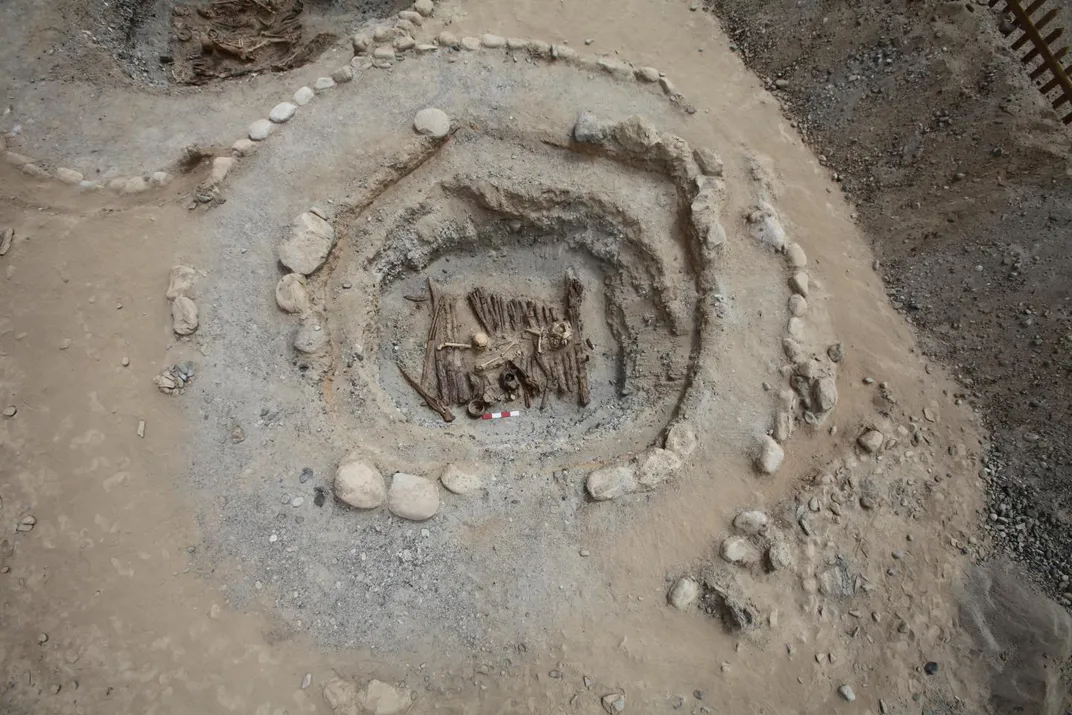The First Evidence of Smoking Pot Was Found in a 2,500-Year-Old Pot
A new study suggests ancient humans used cannabis to commune with nature, spirits or even the dead
/https://tf-cmsv2-smithsonianmag-media.s3.amazonaws.com/filer/d8/f3/d8f35f34-a4e1-4af0-ab6a-cd44cb560db3/203042_web.jpg)
In 440 B.C., Herodotus, an ancient Greek writer popularly dubbed the “father of history,” included an account of ritualistic cannabis use in Book IV of his acclaimed Histories. Recounting the funeral ceremonies of a nomadic Eurasian civilization, the historian reports, “The Scythians, as I said, take some of this hemp-seed, and … throw it upon the red hot stones.” When the hemp began to smoke and release a vapor, the “Scyths, delighted, shout[ed] for joy.”
Herodotus’ writings represent the earliest textual evidence of cannabis’ use as a mind-altering substance. Scientists have long lacked the physical evidence needed to verify his claims, but a new study published in the journal Science Advances is poised to set the record straight once and for all: As researchers from China and Germany report, wooden bowls, or braziers, excavated from a 2,500-year-old cemetery nestled in the mountains of western China bear significant traces of THC, the compound responsible for cannabis’ psychoactive effects.
Speaking at a press conference, study co-author Robert Spengler of Germany’s Max Planck Institute for the Science of Human History said the team’s findings—based on gas chromatography-mass spectrometry analysis—provide “a solid, unequivocal data point for actual use of this plant as a drug,” suggesting that humans have been smoking cannabis since at least 500 B.C. Yimin Yang, senior author and a researcher at the University of Chinese Academy of Sciences, further noted that the braziers’ association with burials points toward their owners’ use of cannabis “to communicate with nature, or spirits, or deceased people.”
According to CNN’s Katie Hunt, the individuals involved in the Jirzankal cemetery rites likely smoked cannabis by burning it on hot stones placed inside of braziers and allowing the vapors, acting similarly to incense, to fill an enclosed space.
“We can start to piece together an image of funerary rites that included flames, rhythmic music, and hallucinogen smoke, all intended to guide people into an altered state of mind,” the scientists write in the study.
The Atlantic’s Matthew Taub writes that previous research has failed to unearth conclusive chemical evidence of ritualized cannabis use. One archaeologist claimed to have identified relevant plant remains inside of ceramic vessels found in Turkmenistan temples, but these containers have since been reclassified as cheese strainers and shown to hold none of the remnants originally reported.

A 2006 study revealed the presence of cannabis seeds in a separate Chinese tomb but offered no indication that the plant had been burned or smoked. A 2016 study detailed a cannabis “burial shroud” draped across the remains of an adult man buried in China’s Turpan Basin. According to Mark Merlin, a cannabis history expert from the University of Hawaii who was not involved in the new research, the shroud constituted “13 cannabis plants gathered at their base and spread across his breast like a bouquet of roses." It remains unclear exactly what purpose this unusual adornment served, but Merlin tells The New York Times’ Jan Hoffman that in conjunction with the Jirzankal finds, the burial identifies cannabis “as a ‘plant of the gods.’” Eventually, Merlin says, “People recognized for it to be effective, you had to cook or burn it.”
Cannabis was domesticated twice, Spengler explained during the briefing. As New Scientist’s Michael Le Page reports, the plant—grown for its seeds, which can be eaten or crushed for oil, and fibers, which can be used to make rope and clothing—first emerged in eastern Asia around 3,500 years ago. Compared to the cannabis varieties identified at Jirzankal, these early strains had decidedly low THC levels, suggesting humans only began cultivating the plant for its mild-altering effects at a more recent point in history.
According to National Geographic’s Michelle Z. Donahue, it’s possible that the individuals behind the burials chanced upon more potent cannabis strains as a result of Jirzankal’s high elevation. (The site is located some 10,000 fet above sea level on the Pamir Plateau, and cannabis grown at higher altitudes is known to have a higher THC content.) Alternatively, the group may have chosen the cemetery site specifically for its ease of access to the plant.
Another possible explanation for the Jirzankal cannabis’ strength is hybridization resulting from migration across the Pamir Plateau, which connects both Central Asia and China to southwest Asia. “While hybridization is another factor known to increase psychoactive cannabis strains’ THC potency,” Donahue writes, “the question of whether it was intentional, or just by happy accident, is ... still unclear.”
Merlin tells the Washington Post’s Joel Achenbach that the scientists’ findings are unsurprising given the textual and circumstantial evidence linking cannabis with religious or spiritual ceremonies. Still, he points out that the research expands the range of sites linked with early cannabis use.
“Modern perspectives on cannabis vary tremendously cross-culturally,” Spengler concludes in a press release, “but it is clear that the plant has a long history of human use, medicinally, ritually, and recreationally, over countless millennia.”
/https://tf-cmsv2-smithsonianmag-media.s3.amazonaws.com/accounts/headshot/mellon.png)
/https://tf-cmsv2-smithsonianmag-media.s3.amazonaws.com/accounts/headshot/mellon.png)